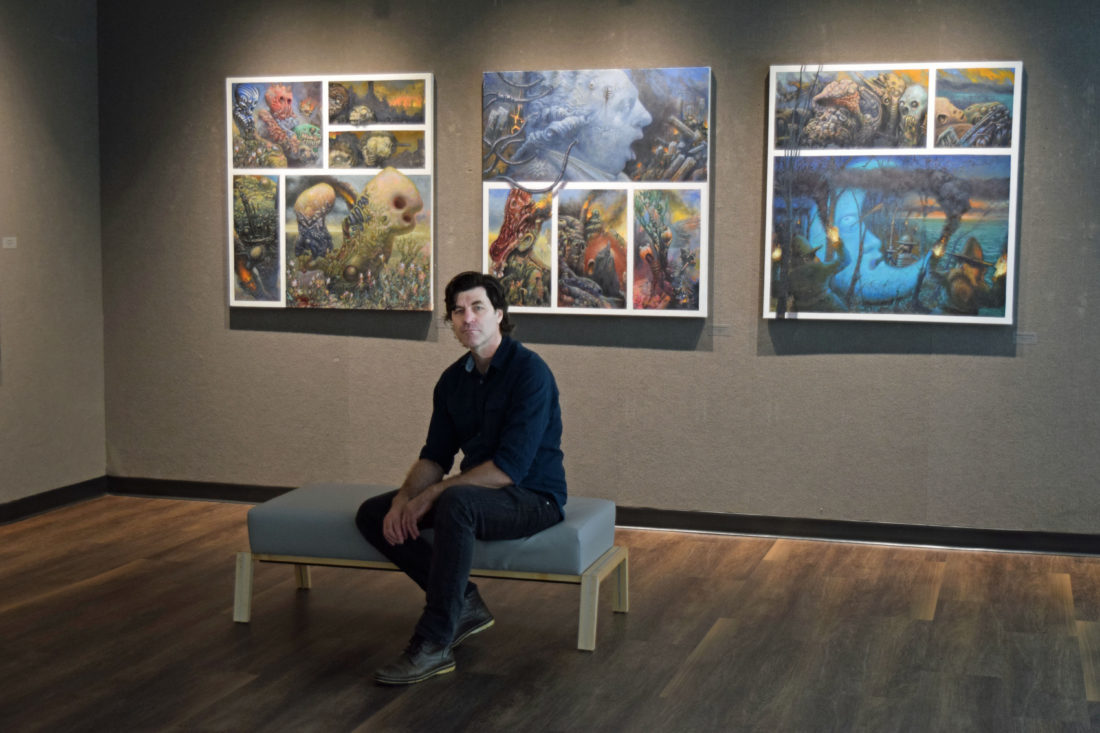For decades, Nick Raynolds considered himself a classical artist, meticulously capturing the world around him on paper and canvas.
But with his latest exhibition, Externalities, he is changing direction. Despite the show’s title, the works do not depict the external world. Instead, they explore Raynolds’ inner vision, combining surrealism with elements of sci-fi and fantasy.
The exhibit runs through Friday, Sept. 29, at D. Hiden Ramsey Library’s Blowers Gallery on the UNC Asheville campus. Raynolds will host an artist’s talk at the gallery on Thursday, Sept. 14, at 1 p.m.
While viewers can enjoy the work without knowing Raynolds’ biography, understanding his past will likely enhance appreciation for his works’ new direction.
Artist’s journey
“I’ve always wanted to be an artist of one sort or another,” Raynolds says.
Growing up on Vancouver Island in British Columbia, he remembers watching his German-born grandfather painting watercolors and collecting images, reproductions and variety of other things. “I’ve still got a box of this stuff,” Raynolds says.
After high school, he spent time with family in Germany. “My uncle is a graphic designer in Düsseldorf,” he says. “He arranged for me to take some figure drawing classes at the Kunstakademie Düsseldorf, the design academy there.”
In 1998, Raynolds returned to Vancouver to get a bachelor’s degree in fine arts from the Emily Carr Institute of Art + Design. But he left the experience dissatisfied. “I was studying late modernist/early conceptualist kind of stuff,” he says. “I didn’t learn what I wanted to learn.”
Relocating to California, Raynolds began screen printing and painting sets for movie studios. “Somewhere along the way,” he says, “I hit this turning point where I asked myself, ‘What do you really want to be doing?'”
The answer: “I want to learn how to draw the figure really well.”
This led Raynolds to Gage Academy of Art in Seattle, where he studied under Anthony Ryder from 1999 to 2000. Next, he headed east to New York City to continue his study at the Water Street Atelier, where he later taught. “You learn how to paint and you pass the information on to the younger generation,” he says.
By the early 2000s, Raynolds had works in galleries in New York, San Francisco and Los Angeles.
Enter the fantastical
Raynolds and his family relocated to Western North Carolina amid the recession.
“We came to Asheville to re-create ourselves,” Raynolds says. “It was this beautiful, interesting little town. It wasn’t a grid like New York City.”
He began teaching at A-B Tech and earned a master’s degree in fine art from East Tennessee State University. During this period, he notes, his childhood interest in monsters began to resurface. “It was almost literally bubbling up,” he says.
Raynolds began to paint still lifes filled with cells and nooks, little humanoids and magical figures from medieval alchemy. Some of his friends, he adds, were confused by his shift. “Suddenly, I was not painting from observation,” he says. “I was making things up and it was becoming fantastical.”
The transition, Raynolds says, “is probably one of the hardest things to do.” And it’s ongoing, he adds. “I’m still trying to figure it out.”
A new way of working
For fellow Asheville artist John Diamond-Nigh, Raynolds’ transition is more an evolution than a break. “Nick’s a phenomenal artist,” he says. “In terms of his skill, he’s maybe the best artist I’ve ever known. He can draw like Raphael.”
But now, Diamond-Nigh says, Raynolds is applying his 16th-century realist skills to scenes from his imagination. “He has a keen sense of the crisis in this country. His current paintings are allegorical, working through that sense of a really traumatized moment.”
Raynolds adds that his new direction draws heavily from comic book art and what he calls low-brow pop. “But there’s something very high-art in the ideas of it,” he continues, citing the man-beast chimeras of the ancient world, the phantasmagorical panoramas of Pieter Bruegel the Elder and Hieronymus Bosch, and the dreamscapes of William Blake.
Diamond-Nigh also finds a similar line of continuity from the Middle Ages to what Raynolds is creating now. “It’s a recurrent fascination that we have with the grotesque,” he says. “It goes back to gargoyles on gothic cathedrals.”
Along with his new direction in subject matter, Raynolds is also changing his creative approach. Years of training developed an intensity “that was driving me crazy,” he says. Instead of obsessing over preliminary studies for each composition, he’s now embracing the unknown.
“That’s been part of the progression he’s made to become more expressionistic,” says Diamond-Nigh. “There actually are elements of abstract painting now in his work.”
But wherever Raynolds’ art may take him next, his mindset hasn’t changed. “My basic rule is that you’ve got to do something every single day,” he says. “That’s how you get good.”
Editor’s note: This article was updated on Sept. 11.



Before you comment
The comments section is here to provide a platform for civil dialogue on the issues we face together as a local community. Xpress is committed to offering this platform for all voices, but when the tone of the discussion gets nasty or strays off topic, we believe many people choose not to participate. Xpress editors are determined to moderate comments to ensure a constructive interchange is maintained. All comments judged not to be in keeping with the spirit of civil discourse will be removed and repeat violators will be banned. See here for our terms of service. Thank you for being part of this effort to promote respectful discussion.